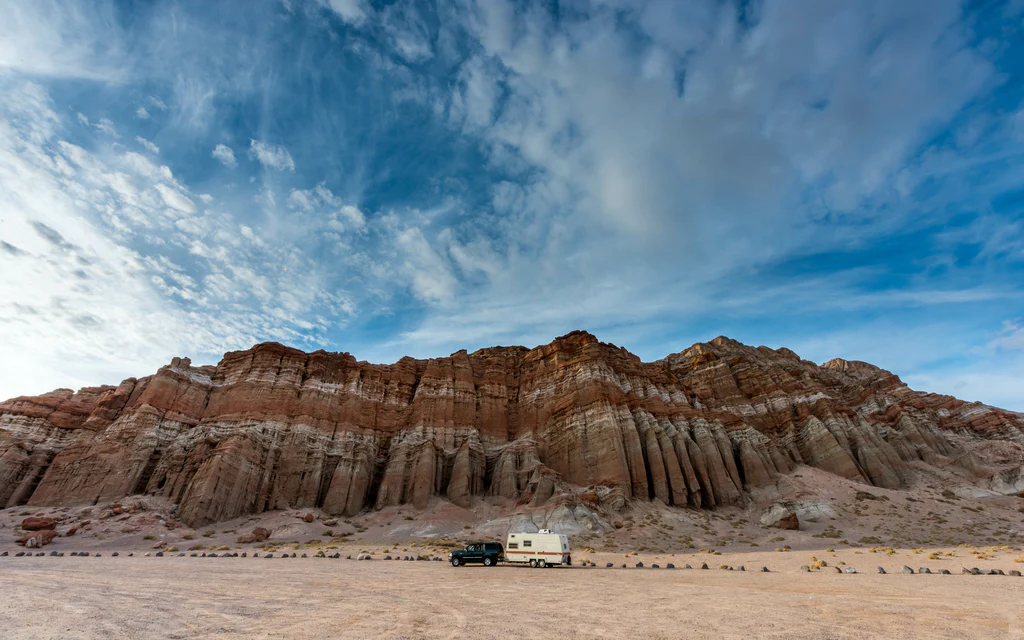5 Tips for Successful Boondocking
Apr 5th 2024

Boondocking, also known as dry camping, is a captivating and fulfilling experience that calls to RVers seeking an adventurous alternative to traditional camping. It allows you to break free from the constraints of established campgrounds and venture into non-traditional sites and remote areas— immersing yourself in the raw beauty of nature.
The appeal of boondocking lies in the opportunity to explore places that are often inaccessible to regular RVers, allowing you to discover hidden gems and revel in the tranquility of undisturbed landscapes. However, boondocking does require careful observance of certain tips and tricks to ensure a successful and enjoyable experience.
In collaboration with the Boundless Bronnekes, expert boondockers, we’ve compiled a list of five vital tips that will serve as your roadmap to having an incredible boondocking adventure:
1) Research Your Campsite
Researching your campsite beforehand is key to a successful boondocking experience. Look for specific site features that align with your preferences. Consider whether there’s shade, scenic views, nearby hiking trails, or fishing spots. Is there ample space, access to water, or reliable cell phone reception?
Acquaint yourself with the local camping regulations for that area. You don’t want to be caught off guard by any rules or restrictions when you arrive.
Many national forests have a 14-day stay limit, whereas the Bureau of Land Management allows up to 30 days. (The BLM is a government agency that manages land mainly in the western part of the U.S.) Other public lands also allow camping (i.e.: state parks, county parks, trust lands, and conservation areas). A permit may be needed, depending on the location.
Utilize resources such as apps, forums, and campground directories to gather information and read reviews from fellow boondockers. The Boondocking app and Campendium website are popular resources. These will help provide a better understanding of what to expect and locate a campsite that suits your wants and needs.
2) Pack Appropriately

Proper packing is key when planning a boondocking excursion. Apart from the obvious necessities like food and water, there are additional essentials to consider. Stock up on non-perishable food that is easy to prepare, as well as kitchen utensils, and grills for outdoor cooking.
Don't forget to bring extra water for drinking, washing dishes, and personal hygiene. Consider investing in a water filtration system, portable toilet, or portable shower for extended stays. They’ll make your trip much more convenient.
Other crucial items include: a first aid kit, extra clothing layers for varying weather conditions, tools for basic repairs, camping tables & chairs, and an insulated cooler to keep your perishable items fresh.
3) Carefully Select Your Spot

When it comes to choosing the perfect boondocking spot, exercise caution and consider the specific needs of your RV or campervan. Research the road conditions leading to the site and ensure your vehicle has sufficient clearance and maneuverability. Look for level ground to park your RV and consider the proximity to nearby attractions or activities.
If you prefer solitude, pick a more secluded location. Those seeking a sense of community can choose spots where other boondockers are known to gather. Additionally, pay attention to any special regulations or restrictions for the area you plan to camp in for a hassle-free experience.
Once you've found a good location, the beauty of boondocking is that you'll be able to set up camp swiftly without hookups!
4) Respect Campsite Etiquette
While boondocking allows for a more flexible camping experience, certain rules and considerations still apply. It's crucial to follow campsite etiquette to maintain the integrity of the locations and promote positive interactions with fellow campers.
Show respect to your fellow campers by keeping music levels low, both during the day and at night to respect the tranquility of the surroundings. Always leave your campsite as you found it (or better) by cleaning up after yourself, properly disposing of waste, extinguishing campfires before leaving the area, and minimizing your impact on the environment. Note: campground-approved portable propane fire pits are great alternatives to natural campfires. They are simple to use and don’t leave a mess behind.
Never discharge gray or blackwater onto the ground. It can attract wildlife— it’s also illegal and unsanitary. Find out where you can dump your gray and black tanks after leaving the site. Facilities like gas stations, truck stops, or RV parks may allow dumping for a small fee.
Remember that boondocking is an opportunity to appreciate nature and engage in sustainable camping practices!
5) Be Prepared For Emergencies

When venturing into remote areas, it's essential to be prepared for unforeseen circumstances or emergencies. Pack a well-stocked first aid kit that includes basic medical supplies and essential prescription medications.
It’s smart to carry roadside emergency tools like a spare tire, jack, jumper cables, and a toolkit to handle unexpected breakdowns. Additionally, have backup power sources (such as portable battery packs or generators) to ensure you can charge devices or power equipment.
This is the time to familiarize yourself with basic wilderness survival skills and have emergency contact numbers readily available.
How’s the weathering looking? You’ll want to pay attention to any changes. Severe weather can happen unexpectedly— something like heavy rain can wash out a dirt road. Check the forecast often and consider getting a weather radio for alerts, especially if you're in an area with no or poor phone signal.
By being prepared, you can confidently handle unexpected situations and ensure your safety off the beaten path.
Happy camping!
With these tips in mind, boldly go on your journey and immerse yourself in the tranquility of unexplored landscapes! It’s time to set off on the open road, embrace the appeal of the unknown, and let the spirit of boondocking guide you to unforgettable adventures.

